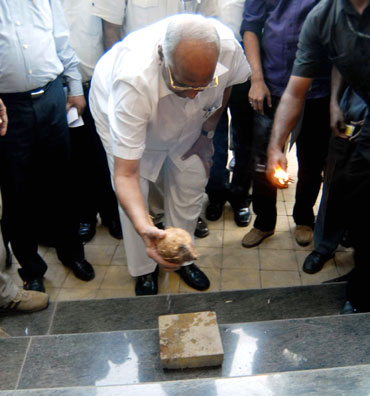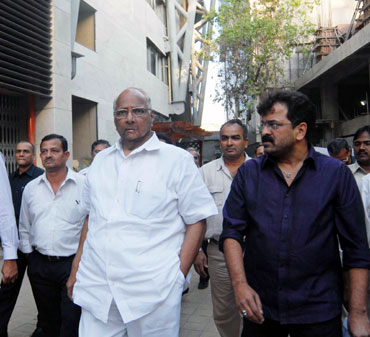Harish Kotian
The Wankhede stadium finally threw its door open on Sunday. Understandably, there was a huge media gathering as officials took scribes around the renovated stands, newly-built players' dressing room, press box and various other facilities.
With Union Agriculture Minister and International Cricket Council president Sharad Pawar at their helm, there was no doubt the Mumbai Cricket Association would deliver a good product, if not word-class, despite delays in constructions due to a few legal wrangles.
Pawar pointed out that the MCA tried to make it one of the best stadiums in the country despite being handicapped for space.
"There were certain issues which had to be resolved for the sake of which we had to undertake renovation or rebuilding of the whole stadium. Mumbai Cricket Association took the decision to rebuild the stadium and provide international standard facilities for spectators and players. We have spent a total of Rs. 275 crore on the renovation," he said, after inaugurating the Wankhede stadium on Sunday evening.
Photographs: Arun Patil
We have not compromised on facilities: MCA
Image: The Wankhede stadiumWorld Cup tournament director Ratnakar Shetty, who is also treasurer of MCA, explained how the association tried to ensure that spectators got the best facilities inside the stadium.
"The stadium built in 1974 had a lot of constraints. The stadium was only built to take care of Test matches and the facilities, therefore, were limited. One-Day Internationals, and now the Twenty20s, put a lot of constraint on the facilities existing in the stadium. Particularly with the IPL, almost 30 percent of the spectators today for an IPL match consist of ladies and children and, therefore, it was very important for us to ensure that there were facilities for that group also in the stands," he said.
The entire seating in the stadium, he added, was changed to bucket seating for the sake of the comfort of spectators at the cost of hurting their pockets.
The previous seating capacity when the spectators were forced to seat on wooden benches and cement blocks was 38,000, but the new seating arrangement meant it has been reduced to 33,317.
"Each and every seat in the stadium is a bucket seat. Therefore, when you go for bucket seats there is a 20 percent reduction in the capacity due to the installation of the bucket seats. The MCA managing committee took a very conscious decision, because we had a choice to look at numbers or compromise in facilities; but we decided not to compromise on the quality of service that would be available to the paying spectator.
"This is a very important decision, because we have faced a lot of criticism in the past -- just like a few stadiums in India -- about the facilities available. We have made a start on that front. We have compromised on numbers but we have not compromised on facilities," he added.
'Drainage at Wankhede similar to Lord's'
Image: ICC and MCA president Sharad Pawar inaugurates the Wankhede stadiumThe renovation work, which stretched around two years, after starting in late 2008, has seen the North and South stands being redeveloped, but the East and West stands retained.
The press and commentary boxes have been shifted to the North Stand, while a new players' dressing room has come up in the first level in the South stand. There will be three replay screens around the ground with integrated scoreboard. The floodlights have also been replaced.
The new outfield, with an improved drainage system, is also on par with international standards, informed Shetty.
"We have gone for a sand-based drainage system in the outfield, which is similar to Lord's. So even if it rains it has the capacity to drain out the water and the ground would be ready for play in a couple of hours. The purpose is not to waste much time during unseasonal rain which we have seen in Mumbai," he said.
'Attendance for non-India matches a concern'
Image: Sharad Pawar inspects the facilities at Wankhede stadiumShetty claimed that there was an option to shift the stadium out of it's current location to the suburbs in Mumbai, an offer given by the Maharashtra government, which was turned down by the association.
"There was a choice by the Maharashtra Government to allot us space in the suburbs to build a stadium, because even the government was keen that we look for another venue for the stadium. But we stuck to this stadium for sentimental reasons, because Wankhede stadium gave Mumbai Cricket Association its own house. If Wankhede stadium had not come up we would be hosting matches in the Brabourne stadium. I think it is a great identity for Mumbai cricket which we could not forget, and for us that sentimental value, or emotional attachment, is something which is important than increasing the capacity or becoming commercially more viable," he said.
The ICC is also worried about low attendances in matches not involving India despite tickets being sold at low rates and school children allowed to enter free in some places.
"The attendance for non-India matches is a matter of concern for us, particularly the matches which start at 9.30 in the morning. India is a country which has a great passion for cricket, but only when India plays; and, therefore, to expect a full house for non-India matches starting at 9.30 it will be an unrealistic thing to talk about. We will make efforts because we want people to be present for the non-India games and I am sure that there will come in good numbers," Shetty said.
'We hope it is a successful and a memorable World Cup'
Image: (From left to right): Ratnakar Shetty, Sharad Pawar, MCA vice-president Dilip Vengsarkar and joint secretary Lalchand RajputDespite boasting of a seating capacity of around 33,000, the number of tickets on sale for the general public through the ticket window is a lowly 3000.
Shetty explained why?
"Mumbai Cricket Association is also unique in another sense because we have contractual obligations to the Garware Club House, the gymkhanas and our clubs. This is something which we cannot avoid because they have to be given tickets at all times.
"For an ICC event, the basic requirement is that the ICC has to be given a specific number of tickets, which works out to about 8500 tickets. So you can calculate that in the total capacity of the stadium, which is around 33,000, we have almost about 20,000 that go to the members, gymkhanas and the Garware Club House and 8500 are given to the ICC for various purposes. Then there are other contractual obligations to the Maharashtra government and the agencies who have a contract with us.
"So the number of tickets which is available to the general public is low and it has been low all the time. This is not something new, but what we have done is that we have reduced the obligation to Garware, the clubs and the gymkhanas so that we can have a certain number of tickets which will be available. So we will have 1000 tickets that will be sold online, while around 3000 will be done for public sale," Shetty said.
The BCCI's chief administrative officer also expressed home that the 2011 World Cup will leave a lasting legacy.
"The last two World Cups in India have been extremely successful. We have a third opportunity to host the World Cup and we hope it is a successful and a memorable World Cup. We also hope that there is great support for all the matches and it is an incident free World Cup."






Comment
article